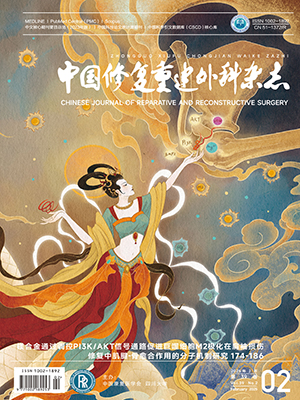| 1. |
Lo IK, Burkhart SS. Arthroscopic revision of failed rotator cuff repairs: technique and results. Arthroscopy, 2004, 20(3): 250-267.
|
| 2. |
Burkhart SS, Danaceau SM, Pearce CE. Arthroscopic rotator cuff repair: Analysis of results by tear size and by repair technique-margin convergence versus direct tendon-to-bone repair. Arthroscopy, 2001, 17(9): 905-912.
|
| 3. |
Shon MS, Koh KH, Lim TK, et al. Arthroscopic partial repair of irreparable rotator cuff tears: preoperative factors associated with outcome deterioration over 2 years. Am J Sports Med, 2015, 43(8): 1965-1975.
|
| 4. |
Rockwood CA, Williams GR, Burkhead WZ. Débridement of degenerative, irreparable lesions of the rotator cuff. J Bone Joint Surg (Am), 1995, 77(6): 857-866.
|
| 5. |
Gerber C, Hersche O. Tendon transfers for the treatment of irreparable rotator cuff defects. Orthop Clin North Am, 1997, 28(2): 195-203.
|
| 6. |
Goutallier D, Postel JM, Bernageau J, et al. Fatty infiltration of disrupted rotator cuff muscles. Rev Rhum Engl Ed, 1995, 62(6): 415-422.
|
| 7. |
Farazdaghi A, Paschos NK, Kelly JD. Comparison between partial and full coverage repair in massive rotator cuff tears. A minimum five year follow-up. Orthop Traumatol Surg Res, 2021, 107(4): 102911.
|
| 8. |
Berth A, Neumann W, Awiszus F, et al. Massive rotator cuff tears: functional outcome after debridement or arthroscopic partial repair. J Orthop Traumatol, 2010, 11(1): 13-20.
|
| 9. |
Li H, Chen Y, Chen J, et al. Large critical shoulder angle has higher risk of tendon retear after arthroscopic rotator cuff repair. Am J Sports Med, 2018, 46(8): 1892-1900.
|
| 10. |
Jeong JY, Kim SJ, Yoon TH, et al. Arthroscopic repair of large and massive rotator cuff tears: complete repair with aggressive release compared with partial repair alone at a minimum follow-up of 5 years. J Bone Joint Surg (Am), 2020, 102(14): 1248-1254.
|
| 11. |
Collin P, Colmar M, Thomazeau H, et al. Clinical and MRI outcomes 10 years after repair of massive posterosuperior rotator cuff tears. J Bone Joint Surg (Am), 2018, 100(21): 1854-1863.
|
| 12. |
Donohue KW, Ricchetti ET, Ho JC, et al. The association between rotator cuff muscle fatty infiltration and glenoid morphology in glenohumeral osteoarthritis. J Bone Joint Surg (Am), 2018, 100(5): 381-387.
|
| 13. |
Goutallier D, Postel JM, Gleyze P, et al. Influence of cuff muscle fatty degeneration on anatomic and functional outcomes after simple suture of full-thickness tears. J Shoulder Elbow Surg, 2003, 12(6): 550-554.
|
| 14. |
郑小龙, 唐康来. 巨大肩袖撕裂治疗的研究进展. 中国修复重建外科杂志, 2021, 35(1): 8-13.
|
| 15. |
Burkhart SS, Nottage WM, Ogilvie-Harris DJ, et al. Partial repair of irreparable rotator cuff tears. Arthroscopy, 1994, 10(4): 363-370.
|
| 16. |
Ishigaki N, Hata Y, Matsuba T, et al. Long-term results of partial repair for irreparable rotator cuff tear. JSES Int, 2021, 5(4): 642-648.
|
| 17. |
Kim SJ, Lee IS, Kim SH, et al. Arthroscopic partial repair of irreparable large to massive rotator cuff tears. Arthroscopy, 2012, 28(6): 761-768.
|
| 18. |
Galasso O, Riccelli DA, De Gori M, et al. Quality of life and functional results of arthroscopic partial repair of irreparable rotator cuff tears. Arthroscopy, 2017, 33(2): 261-268.
|
| 19. |
McElvany MD, McGoldrick E, Gee AO, et al. Rotator cuff repair: published evidence on factors associated with repair integrity and clinical outcome. Am J Sports Med, 2015, 43(2): 491-500.
|
| 20. |
Rojas G, Perelli S, Ibanez M, et al. Effect of modified lemaire anterolateral extra-articular tenodesis on the magnetic resonance imaging maturity signal of anterior cruciate ligament hamstring graft. Am J Sports Med, 2021, 49(9): 2379-2386.
|
| 21. |
Liu S, Xie Y, Chen Q, et al. Tendon healing progression evaluated with magnetic resonance imaging signal intensity and its correlation with clinical outcomes within 1 year after rotator cuff repair with the suture-bridge technique. Am J Sports Med, 2020, 48(3): 697-705.
|




